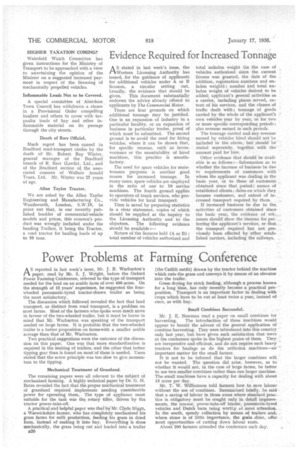Power Problems at Farming Conference
Page 34

If you've noticed an error in this article please click here to report it so we can fix it.
AS reported in last week's issue, Mr. J. R. Warburton's paper, read by Mr. S. J. Wright, before the Oxford Power Farming Conference, refeliecl to the type of transport needed for the land on an arable farm of over 400 acres. On the strength of 12 years' experience, he suggested the fourwheeled pneumatic-.tyred tractor-drawn trailer as being the most satisfactory.
The discussion which followed revealed the fact that laud transport, as distinct from road transport, is a problem on most farms. Most of the farmers who spoke were much more in favour of the two-wheeled trailer, but it must be borne in mind that Mr. Warburton was speaking of the transport neededon large farms. It is probable that the two-wheeled trailer is a better Proposition on farms with a 'smaller arable acreage than that of Mr. Warburton.
Two practical suggestions were the outcome of the discussion an this paper. One was that more standardization is required in the making of trailers, and the other that better tipping gear than is found on most' of them is needed. Users stated that the screw principle was too slow to give momentum to the tipping.
Mechanical Treatment of Grassland.
The remaining papers were all relevant to the subject of mechanized farming. A highly technical paper by Dr. G. H. Bates revealed the fact that the proper mechanical treatment of grassland required implements needing considerable power for operating them. The type of appliance most suitable for the task was the. rotary tiller, driven by the tractor power-take-oft.
A practical and helpful paper was that by Mr. Clyde Higgs, a Warwickshire farmer, who has completely mechanized his grass farms for milk production, feeding his grass in dried form, instead of making it into hay. Everything is done mechanically, the grass being cut and loaded into a trailer B20 (the Cutlift outfit) drawn by the tractor behind the machine which cats the grass and conveys it by means of an elevator into the trailer.
Grass drying for stock feeding, although a process known for a long time, has only recently became a practical pre' position. Transport is an important factor in dealing with crops which have to be cut at least twice a year, instead of once, as with hay.
Small Combines Successful.
Mr. J. E. Newman read a paper on small combines for harvesting. The introduction of these machines would appear to herald the advent of the general application of combine harvesting. They were introduced into this country only last year, but have given such satisfaction that 'users at the conference spoke in the highest praise of them. They .“ are inexpensive and efficient, and do not require such heavy tractors for haulage as do the orthodox machines—an important matter for the small farmer.
It is not to be inferred that the larger combines will not be wanted. The question did arise, however, as to whether it would not, in the case of large farms, be better to use two smaller combines rather than one larger machine. The small machines have a capacity for dealing with about 15 acres per day.
Mr. T. W. Williamson told farmers how to save labourwithout the use of combines. Summarized briefly, he said that a saving of labour in those areas where standard practice is obligatory must be sought only in detail improvements, the tractor, power-take-oil binder, pnenmatic-tyred vehicles and Dutch barn being worthy, uf most attention, In the south, speedy collection by means of trailers and, where straw is of little importance, the grain _drier, offer most opportnnities of cutting down labour costs.
About 200 farmers attended the conference each day.




























































































